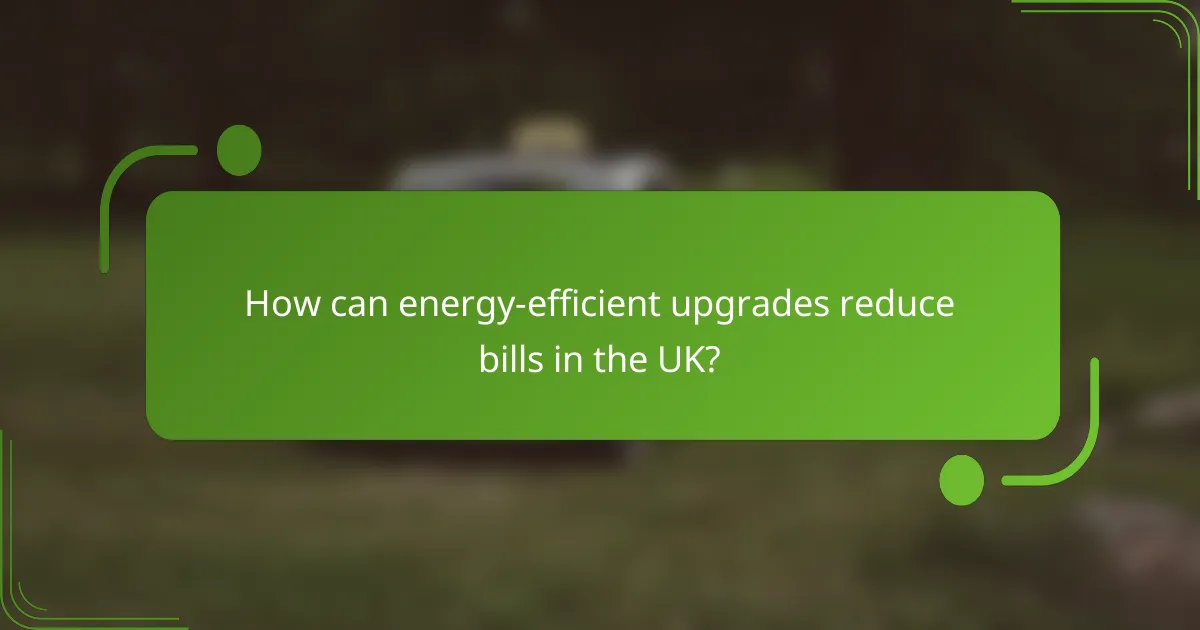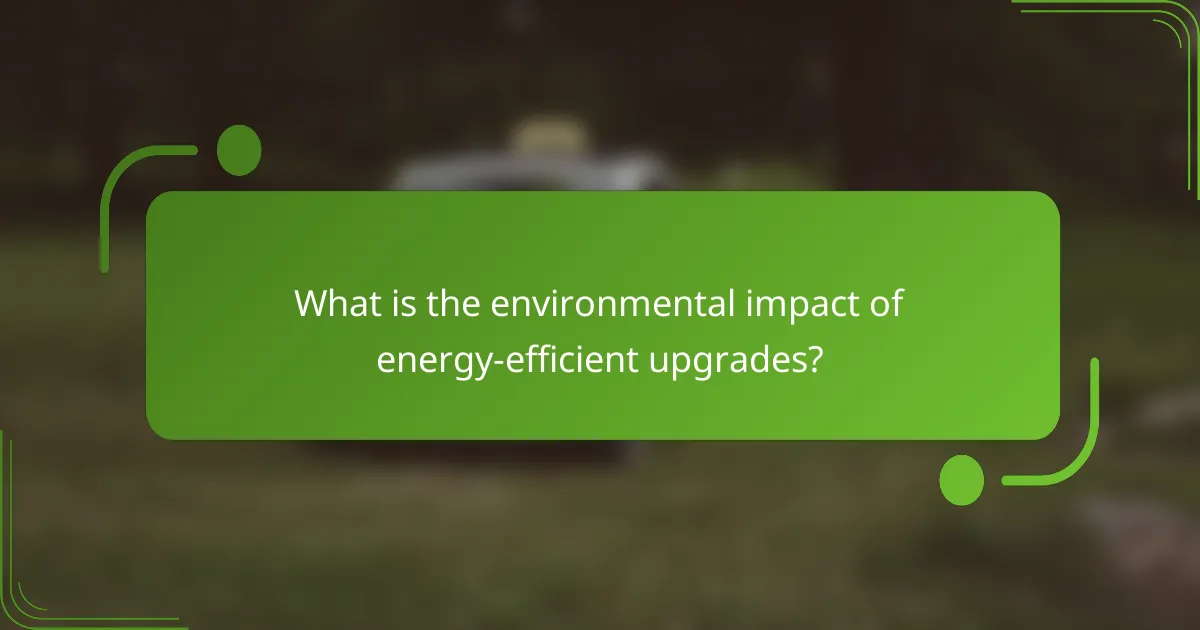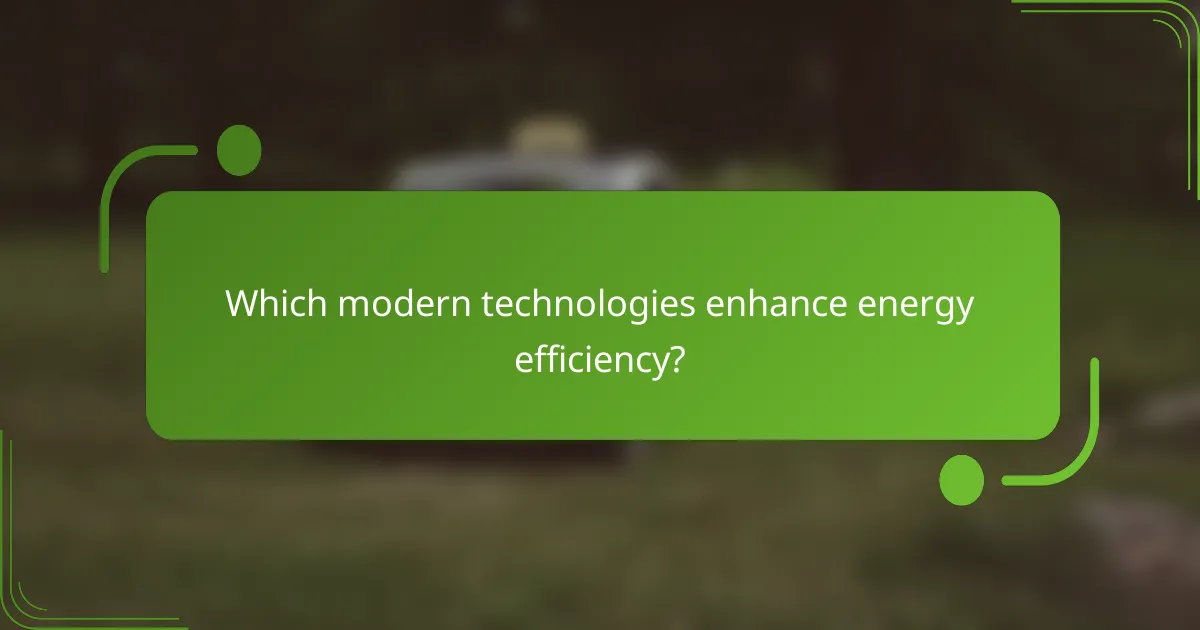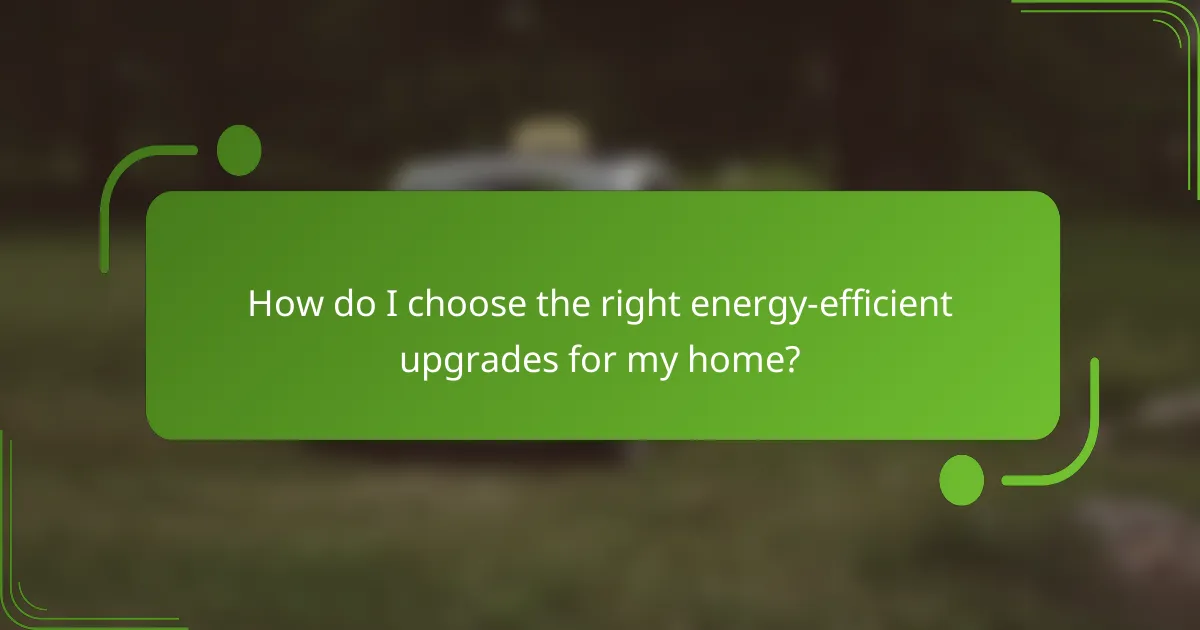Upgrading to energy-efficient solutions can lead to substantial savings on utility bills while also benefiting the environment. By incorporating modern technologies such as LED lighting and high-efficiency HVAC systems, homeowners can significantly reduce their energy consumption and greenhouse gas emissions. These upgrades not only promote financial savings but also contribute to a healthier planet for future generations.

How can energy-efficient upgrades reduce bills in the UK?
Energy-efficient upgrades can significantly lower utility bills in the UK by reducing overall energy consumption and optimizing the use of modern technology. These improvements not only save money but also contribute to a reduced environmental impact.
Lower energy consumption
Lower energy consumption is a direct result of implementing energy-efficient upgrades in homes and businesses. By replacing outdated appliances with energy-efficient models, households can reduce their electricity usage by up to 30%. Simple changes, such as switching to LED lighting and improving insulation, can further decrease energy demands.
For example, upgrading to an A-rated boiler can lead to substantial savings on heating bills, especially during the colder months. Additionally, sealing drafts and insulating walls can prevent heat loss, ensuring that less energy is required to maintain comfortable indoor temperatures.
Government incentives and rebates
The UK government offers various incentives and rebates to encourage energy-efficient upgrades. Programs like the Energy Company Obligation (ECO) provide financial support for low-income households to improve their energy efficiency. This can include grants for insulation, heating systems, and other energy-saving measures.
Homeowners can also benefit from the Green Homes Grant, which allows for funding to cover a portion of the costs associated with energy-efficient improvements. These incentives can significantly reduce the upfront costs, making it easier for individuals to invest in upgrades that lead to long-term savings.
Smart thermostats and energy monitors
Smart thermostats and energy monitors play a crucial role in optimizing energy use and reducing bills. Smart thermostats allow users to program heating schedules and adjust temperatures remotely, ensuring that energy is not wasted when homes are unoccupied. Many models can learn user habits and automatically adjust settings for maximum efficiency.
Energy monitors provide real-time feedback on energy consumption, helping users identify high-usage appliances and adjust their habits accordingly. By understanding where energy is being consumed, households can make informed decisions to further decrease their bills and enhance overall energy efficiency.

What is the environmental impact of energy-efficient upgrades?
Energy-efficient upgrades significantly reduce environmental impact by lowering energy consumption and greenhouse gas emissions. These improvements not only lead to reduced utility bills but also contribute to a healthier planet.
Reduced carbon footprint
Implementing energy-efficient upgrades can lead to a notable decrease in carbon emissions. For instance, switching to LED lighting or high-efficiency appliances can cut energy use by 20-50%, which directly translates to fewer greenhouse gases released into the atmosphere.
Homeowners can further reduce their carbon footprint by utilizing renewable energy sources, such as solar panels, which can offset the carbon emissions associated with traditional energy consumption. This shift not only benefits the environment but can also enhance property value.
Conservation of natural resources
Energy-efficient upgrades help conserve natural resources by reducing the demand for fossil fuels and other non-renewable energy sources. By using less energy, households and businesses lessen the strain on resources like coal, oil, and natural gas.
For example, energy-efficient appliances and insulation can lower energy consumption, which in turn decreases the need for resource extraction and processing. This conservation is crucial for sustainable development and maintaining ecological balance.
Improved air quality
Upgrading to energy-efficient systems can lead to improved indoor and outdoor air quality. Energy-efficient appliances often produce fewer emissions, which helps reduce air pollution and its associated health risks.
Additionally, better insulation and ventilation systems can prevent the buildup of indoor pollutants, creating a healthier living environment. This is particularly important in urban areas where air quality is often compromised by industrial and vehicular emissions.

Which modern technologies enhance energy efficiency?
Modern technologies that enhance energy efficiency include LED lighting, high-efficiency HVAC systems, and smart home automation. These innovations not only reduce energy consumption but also lower utility bills and minimize environmental impact.
LED lighting solutions
LED lighting solutions are significantly more energy-efficient than traditional incandescent bulbs, consuming up to 80% less energy. They have a longer lifespan, often lasting over 25,000 hours, which reduces replacement costs and waste.
When upgrading to LED lighting, consider the lumens per watt ratio to ensure optimal brightness for your space. Look for Energy Star-rated products to guarantee quality and efficiency.
High-efficiency HVAC systems
High-efficiency HVAC systems utilize advanced technology to heat and cool spaces more effectively, often achieving energy savings of 20-50% compared to standard systems. Features like variable-speed motors and smart thermostats help optimize energy use based on real-time conditions.
When selecting an HVAC system, check the Seasonal Energy Efficiency Ratio (SEER) rating, aiming for a minimum of 15 SEER for optimal efficiency. Regular maintenance, such as changing filters and cleaning ducts, is crucial for maintaining performance.
Smart home automation
Smart home automation systems allow homeowners to control lighting, heating, and appliances remotely, leading to significant energy savings. By scheduling devices to operate only when needed, users can reduce unnecessary energy consumption.
Consider integrating smart thermostats and smart plugs into your home. These devices can learn your habits and adjust settings automatically, providing convenience while enhancing energy efficiency. Be mindful of compatibility with existing systems to ensure seamless integration.

What are the costs associated with energy-efficient upgrades?
The costs associated with energy-efficient upgrades can vary widely based on the type of upgrade, the size of the property, and local labor rates. While the initial investment may seem high, these upgrades often lead to significant long-term savings on utility bills and reduced environmental impact.
Initial investment vs. long-term savings
Energy-efficient upgrades typically require a substantial initial investment, which can range from a few hundred to several thousand dollars, depending on the project. However, these upgrades can lead to long-term savings on energy bills, often reducing costs by 20-50% over time.
For example, replacing old windows with energy-efficient models may cost around $10,000 upfront but can save homeowners hundreds of dollars annually on heating and cooling costs. Over a decade, this can translate to thousands in savings, making the investment worthwhile.
Financing options available
Homeowners can explore various financing options for energy-efficient upgrades, including personal loans, home equity lines of credit, and specialized energy efficiency loans. Many local governments and utility companies also offer rebates and incentives to offset initial costs.
Programs like the Property Assessed Clean Energy (PACE) financing allow homeowners to pay for upgrades through property taxes, spreading the cost over time. This can make energy-efficient upgrades more accessible without a significant upfront burden.
Cost-benefit analysis
Conducting a cost-benefit analysis is crucial before committing to energy-efficient upgrades. This involves comparing the total costs of the upgrade against the expected savings on energy bills, maintenance, and potential increases in property value.
Homeowners should consider factors like payback period, which is the time it takes for savings to equal the initial investment. A payback period of five to seven years is generally considered favorable, as it indicates a good return on investment.

How do I choose the right energy-efficient upgrades for my home?
Choosing the right energy-efficient upgrades involves assessing your home’s energy use, understanding local climate conditions, and prioritizing improvements based on return on investment (ROI). Start by identifying the most impactful changes that can reduce your energy bills and environmental footprint.
Assessing home energy audit results
A home energy audit provides valuable insights into where your home is losing energy. This assessment typically includes an examination of insulation, windows, heating and cooling systems, and appliances. Look for areas with significant energy loss, as these are prime candidates for upgrades.
Consider hiring a certified energy auditor who can provide a detailed report and recommendations. Many utility companies offer incentives or rebates for conducting these audits, making it a cost-effective first step.
Evaluating local climate conditions
Your local climate significantly influences which energy-efficient upgrades will be most beneficial. For example, homes in colder regions may prioritize insulation and efficient heating systems, while those in warmer climates might focus on cooling systems and shading solutions.
Research local weather patterns and seasonal temperature variations to guide your decisions. Understanding these factors helps ensure that your upgrades will provide maximum comfort and efficiency throughout the year.
Prioritizing upgrades based on ROI
Not all energy-efficient upgrades offer the same return on investment. Start by evaluating the potential savings from each upgrade against its cost. For instance, replacing old windows may have a higher upfront cost but can lead to significant long-term savings on heating and cooling bills.
Use a simple ROI calculation: divide the annual savings by the initial investment to determine how quickly you’ll recoup your costs. Focus on upgrades with shorter payback periods, typically within five to ten years, to maximize your investment.

What are the benefits of government programs for energy efficiency?
Government programs for energy efficiency offer significant advantages, including reduced energy bills and a lower environmental impact. These initiatives often provide financial support and resources to help homeowners upgrade to modern, energy-efficient technologies.
Financial incentives for homeowners
Many government programs provide financial incentives such as rebates, tax credits, or grants to encourage homeowners to invest in energy-efficient upgrades. These incentives can cover a substantial portion of the costs associated with purchasing energy-efficient appliances, insulation, or renewable energy systems.
For example, homeowners might receive rebates that range from a few hundred to several thousand dollars, depending on the type of upgrade and local regulations. This financial assistance can significantly reduce the upfront costs, making energy-efficient options more accessible.
Access to expert consultations
Government energy efficiency programs often include access to expert consultations, allowing homeowners to receive personalized advice on the best upgrades for their specific needs. These consultations can help identify energy-saving opportunities and provide guidance on available incentives.
Homeowners can benefit from assessments that evaluate their current energy use and suggest practical improvements. This expert insight can lead to better decision-making and ensure that investments in energy efficiency yield the highest possible returns in terms of savings and environmental impact.
